Spaghetti pomodoro or pasta pomodoro is an Italian tomato and basil pasta recipe beloved worldwide for its taste and simplicity.
In about 20 minutes, with simple ingredients, you can prepare an authentic Italian pasta dish that will leave everyone begging for more.
Add mozzarella balls and baby spinach to make it a nutritious and fulfilling dinner.

What is Spaghetti Pomodoro?
Pomodoro means tomato in Italian, and spaghetti al pomodoro is a classic Italian tomato basil pasta recipe.
It is a simple meal with a flavor-packed sugo (sauce), and probably one of our favorite easy pasta recipes.
It is similar to penne arrabbiata, spaghetti assassina, and cherry tomato pasta, but more saucy.

Everyone, and I mean that, loves this recipe, from babies to picky adults. Spaghetti al pomodoro is THE dish for a last-minute family dinner.
We like to add mozzarella balls and baby spinach to make it more nutritious and fulfilling. It’s simple, healthy, and delicious!
Ingredients

Quantities are in the recipe box at the bottom of the page.
Spaghetti
Try to get Italian pasta made from durum wheat semolina flour and water.
Here, we use bronze-cut spaghetti, but honestly, this tomato basil pasta sauce is delicious with any pasta shape, from linguine and bucatini to penne and rigatoni.
You can also use the sauce with angel hair pasta and whole wheat pasta.
Canned tomatoes
San Marzano tomatoes (peeled whole and canned) are best for making spaghetti Pomodoro because they produce a thick sauce with a hint of sweetness.
If you can’t find San Marzano, go for generic whole-peeled canned tomatoes, preferably from an imported Italian brand. Good ones are Mutti, Cento, or Cirio.
Canned tomatoes from Italian brands are usually sweeter than others because they are made with sun-ripen tomatoes.
If you are using a non-Italian brand, you might need to add a teaspoon or two of sugar to balance the tomatoes’ acidity. Taste and adjust the sauce accordingly.
Fresh tomatoes
We recommend cherry tomatoes or plum tomatoes. They are easy to find and add natural sweetness.
Olive oil
Extra virgin olive oil is best because it has a richer and fruitier flavor, but regular olive oil works, too.
Garlic
A couple of fresh garlic cloves are a must in pasta Pomodoro.
You can add crushed cloves for a milder garlic flavor or finely minced cloves for a more robust flavor.
The authentic Italian recipe calls for crushed garlic.
There’s no onion in pasta Pomodoro; however, if you want to add it, feel free to do so at the beginning and sauté it with the olive oil for 3 minutes.
Fresh basil
We add fresh basil to our spaghetti pomodoro, although this is not always common in Italy.
Substitute dried oregano for basil.
Red pepper flakes
Red pepper flakes are optional. You can substitute fresh chilies, dried chilies, or cayenne pepper for red pepper flakes.
Salt and black pepper
Salt is necessary to cook the pasta (we recommend coarse sea salt) and to season the sauce (we recommend fine sea salt or kosher salt).
We also add a few twists of freshly ground black pepper to the sugo.
Add-ins (optional)
You can enrich pasta pomodoro with several ingredients to make it a complete dinner.
Here, we add small mozzarella balls and baby spinach.
Other options include grated parmesan cheese and butter.
For vegans, there are many dairy-free alternatives available these days; however, this spaghetti Pomodoro recipe is also delicious without cheese or butter.

How to make pasta al pomodoro
US cups + grams measurements in the recipe box at the bottom of the page.
1. Start with the pomodoro sauce
Cut the cherry tomatoes in half and set them aside.
Heat the olive oil in a large skillet or Dutch oven.
Add grated garlic and red pepper flakes, and sauté for 1 minute.
Add the halved cherry tomatoes, salt, black pepper, and sauté on medium-high heat for 4 minutes.
Add the canned whole peeled tomatoes and simmer for 15 minutes while you cook the pasta.
Stir occasionally and crush the tomatoes with a wooden spoon.
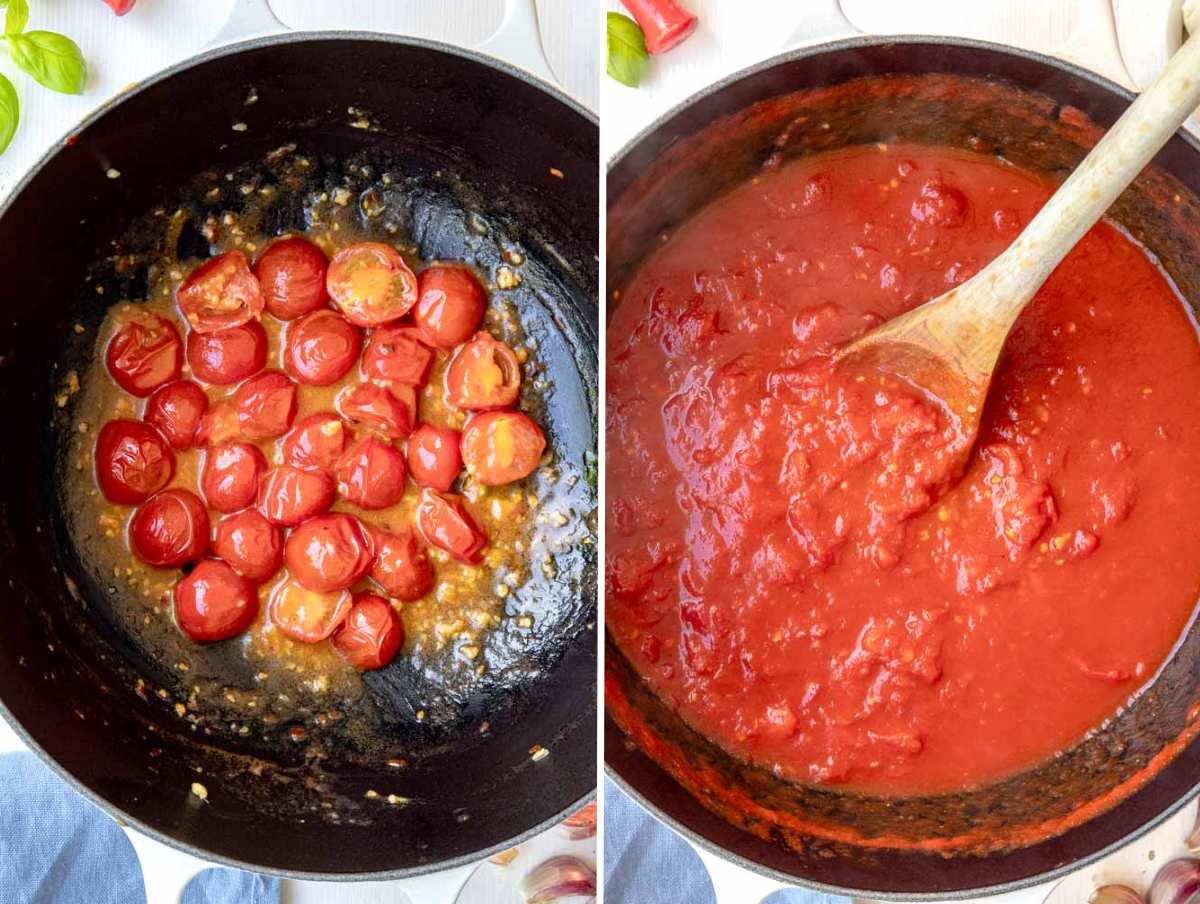
2. Cook the pasta
Cook the pasta in a large pot of salted boiling water as per package instructions minus 3 minutes.
Reserve one cup of pasta cooking water, drain the pasta, and add it to the pot with the tomato sauce.
Add chopped basil leaves and cook the pasta in the sauce for 2 to 3 minutes or until cooked with a bite (al dente). Stir often.
Add some of the reserved pasta water if the sauce is too thick.

Tip: We undercook the pasta and then finish cooking it in the tomato sauce. This trick makes the sauce creamier, thanks to the starch in the pasta leaching into the tomato sauce.
3. Serving suggestions
Turn the heat off, and then, optionally, add mozzarella balls or grated parmesan cheese and baby spinach.
Serve spaghetti al pomodoro with a drizzle of extra virgin olive oil and some basil or spinach on top.
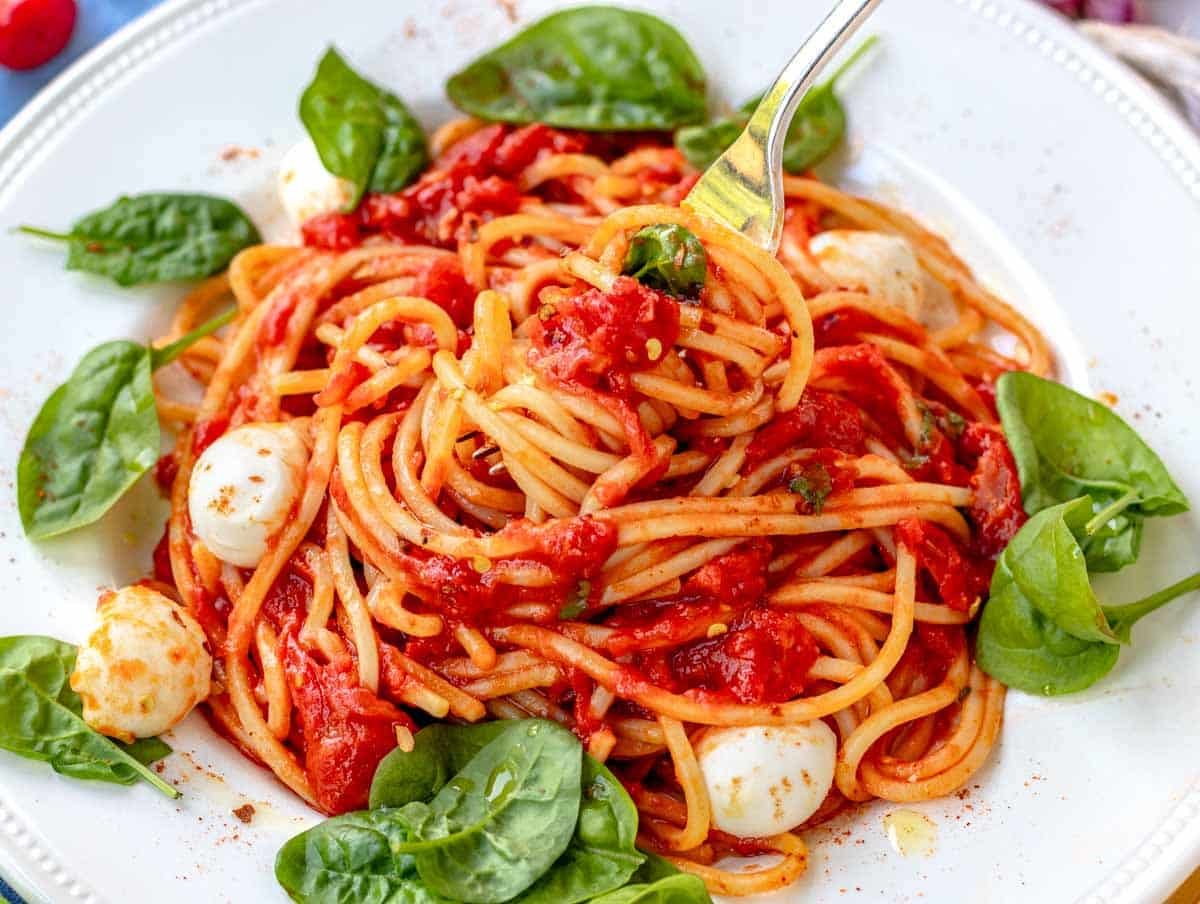
Alternatively, you can serve pasta al pomodoro with a side salad like our simple side salad, Italian salad, fennel and orange salad, cucumber and tomato salad, or green bean salad.
Of course, don’t forget to sop up the leftover tomato sauce with a small piece of crusty bread (this is called “Scarpetta” in Italian).
Storage
Refrigerator: Keep leftovers in an airtight container in the fridge for 3 days.
Reheat: Warm leftover pasta pomodoro in the microwave for 2 minutes. Alternatively, sauté on a skillet for a couple of minutes with a tablespoon of olive oil.

History of pasta al pomodoro
The first pasta al pomodoro recipe was published by Ippolito Cavalcanti, a chef from Naples, in 1837.
It was such a hit that it became a national dish in a few years.
The recipe was published in the Neapolitan dialect; I translated it to English below. Despite being written in 1837, it feels incredibly modern.
Here’s the English translation.
“Spaghetti al Pomodoro: when it is the season, you will take 6 pounds of tomatoes, cook them, and mash them; then take 1 ounce of lard, or 2 tablespoons of oil, fry it with a head of garlic, and put it in the sauce. Boil 4 pounds of spaghetti, drain them when they are al dente, and throw them into the sauce; fill them with pepper, add salt, and you’ll see what you eat.”
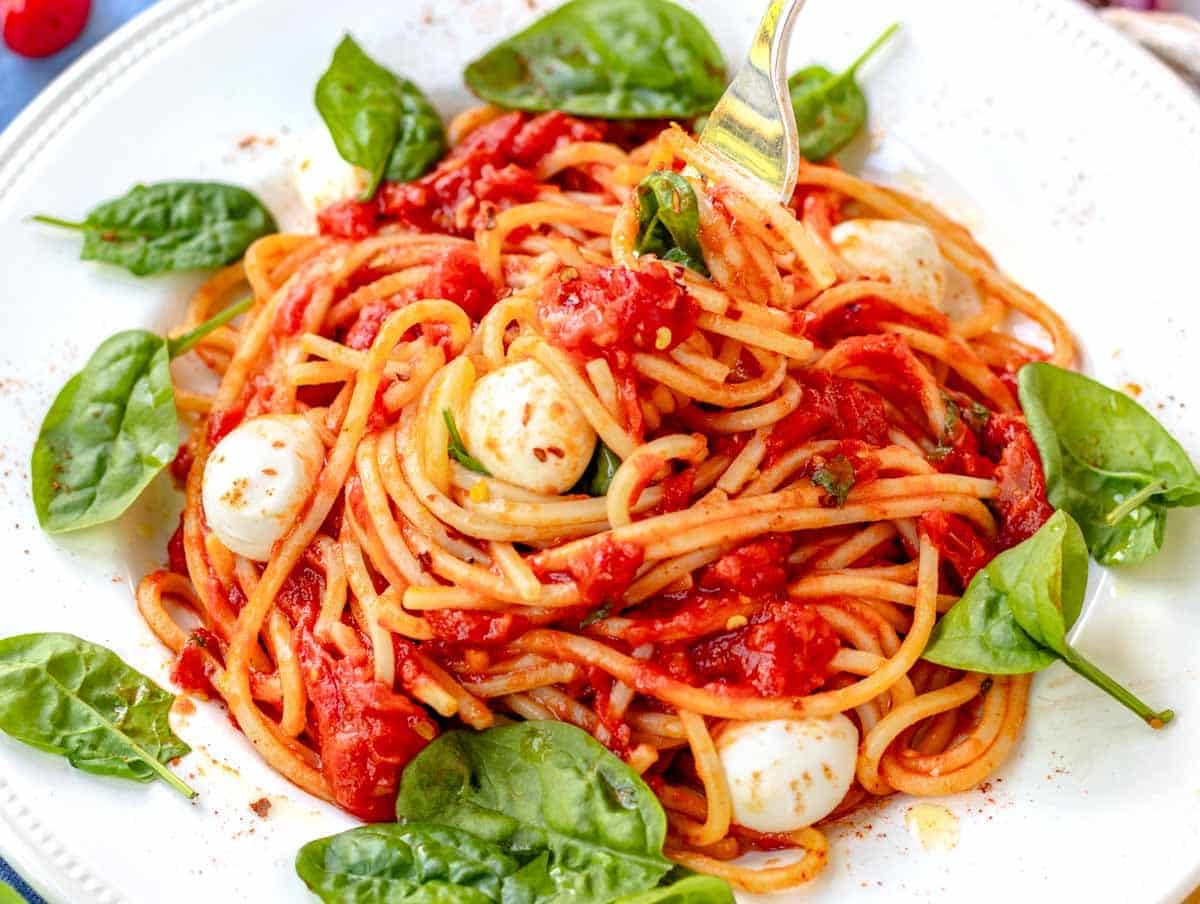
Questions
The modern spaghetti al pomodoro recipe does not contain meat or fish (including chicken, sausage, and shrimp).
The original Italian recipe from 1837 combines lard with olive oil to make the flavor base.
Pomodoro and marinara sauce are both tomato-based sauces made with olive oil, garlic, and occasionally red pepper flakes.
Pomodoro sauce is generally seasoned with basil, while marinara sauce with oregano and parsley.
In Italy, Pomodoro sauce is used for pasta, while the marinara sauce is mainly used for pizza, calzone, bread, and meat.
More Easy Pasta
Some of our reader’s favorite pasta recipes are lentil bolognese, mushroom ragu, mushroom Alfredo, spaghetti Aglio e Olio, creamy mushroom pasta, lemon pasta, and broccoli pasta.
For more ideas, check out our compilation of 40 easy pasta recipes.

Pasta Pomodoro
Ingredients
- 12 ounces spaghetti or another pasta shape / cooked in 3 quarts/12 cups/3 Liters water and 1½ tablespoons/21 grams sea salt.
For the pasta sauce
- 3 tablespoons extra virgin olive oil
- 2 cloves garlic grated
- ¼ teaspoon red pepper flakes more or less to taste
- 10 ounces cherry tomatoes halved
- 1 large can (28 ounces) whole peeled tomatoes best if San Marzano
- 1 teaspoon salt or more to taste
- ⅛ teaspoon black pepper
- 15 leaves basil
- 1 cup fresh mozzarella balls the small ones
- 2 cups baby spinach
Instructions
- MAKE SAUCE: Cut 10 ounces cherry tomatoes in half and set them aside.Heat 3 tablespoons extra virgin olive oil in a large skillet or Dutch oven.Add 2 cloves garlic (grated) and ¼ teaspoon red pepper flakes, and sauté for 1 minute.Add the halved cherry tomatoes, 1 teaspoon salt, ⅛ teaspoon black pepper, and sauté on medium-high heat for 4 minutes.Add 1 large can (28 ounces) whole peeled tomatoes and simmer for 15 minutes while you cook the pasta.Stir occasionally and crush the tomatoes with a wooden spoon.
- COOK PASTA: Cook 12 ounces spaghetti in a large pot of salted boiling water as per package instructions, minus 3 minutes.Reserve one cup of pasta cooking water, drain the pasta, and add it to the pot with the tomato sauce.Add 15 leaves basil (chopped) and cook the pasta in the sauce for 2 to 3 minutes or until cooked with a bite (al dente). Stir often.Add some of the reserved pasta water if the sauce is too thick.
- SERVES WELL WITH: Turn the heat off, and then, optionally, add 1 cup fresh mozzarella balls or grated parmesan cheese and 2 cups baby spinach (or more).Serve spaghetti al pomodoro with a drizzle of extra virgin olive oil and some basil or spinach on top.
Video
Notes
Nutrition
I grew up eating sooooo much pasta al pomodoro! It’s the go-to recipe for busy parents and grandparents in Italy.
Here’s a picture of me when I was three years old, eating spaghetti al pomodoro at my nonnas place in Todi, Italy. I was already rolling the pasta like a boss!


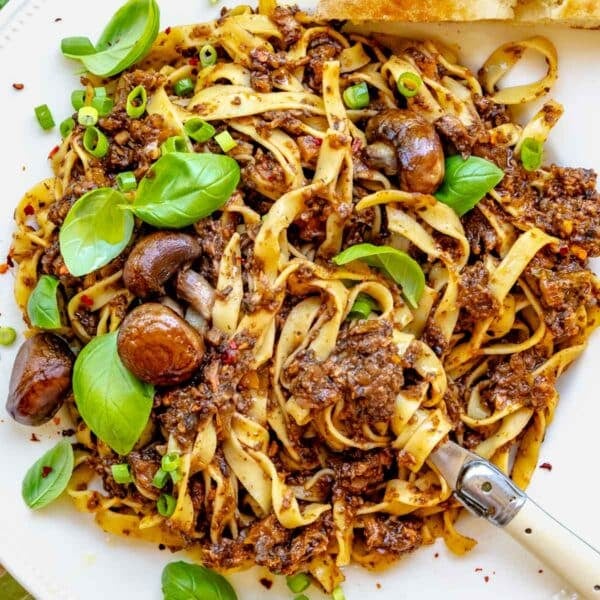
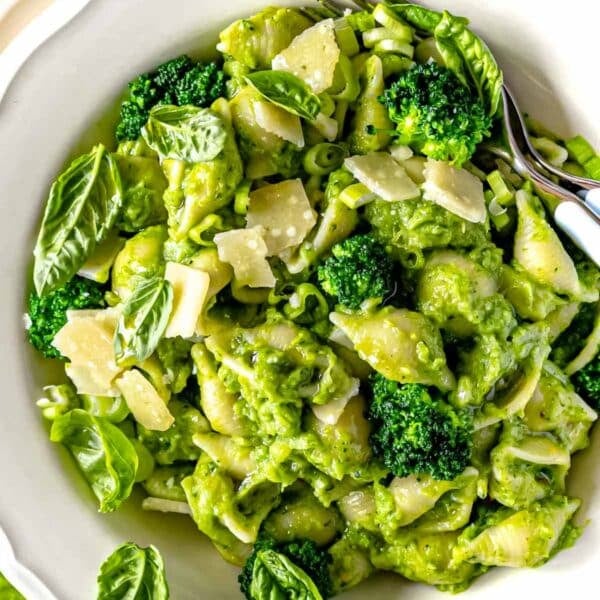
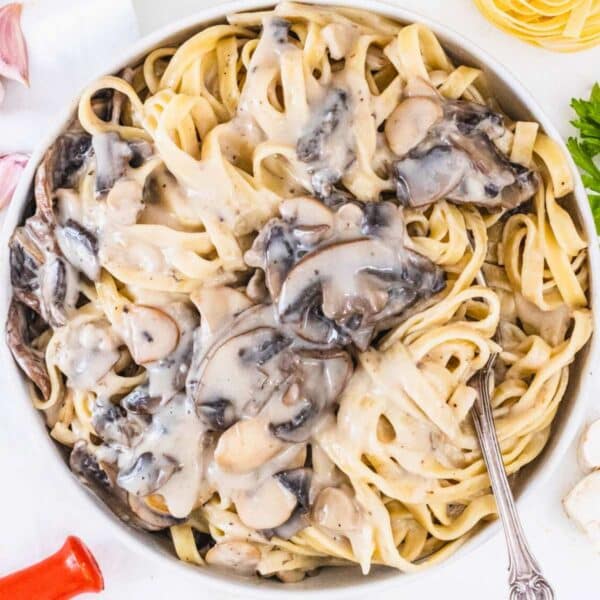
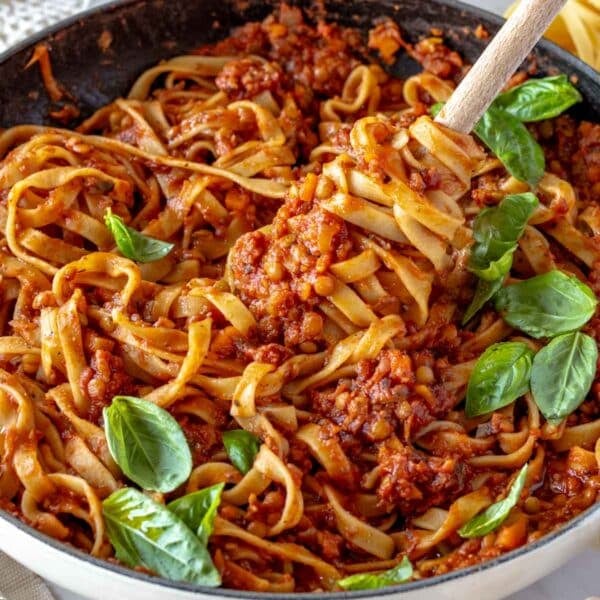




would like to add spinach or greens for a health boost- when do you think it would be best to do that?
Hi there,
Thanks for your message.
Add spinach towards the end, once your sauce is almost ready. They should wilt quickly, within a minute or two, then you can add the pasta.
I hope this helps 🙂
Nico
I love this recipe, it’s so simple, yet so good. The combination of fresh and canned tomatoes and bronze cut pasta is perfect 💚🤍❤️
Thank you sooo much Lenore! We are so happy you liked it 🙂
Hello Nico, what is the culinary tool that you use to serve the pasta with that creates a nice swirl of the pasta? Thank you. I really enjoy your recipe video’s!
W
Hi Cherry! Thanks so much, I’m happy you like our videos 🙂 I use a ladle to make the “bouquet” of pasta and a food tweezer to grab and control the pasta. I hope that helps! Cheers, Nico